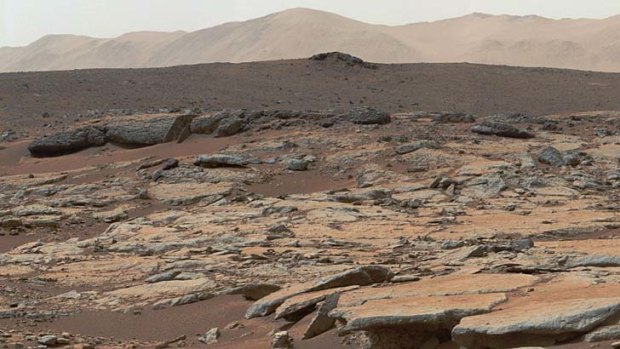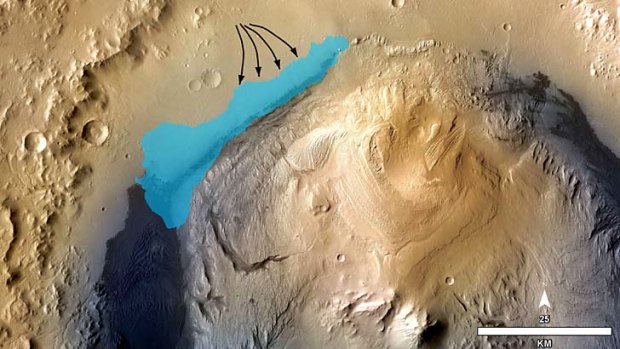By Kerry Sheridan
NASA's Curiosity rover has found remnants of an ancient freshwater lake on Mars that may have supported tiny life forms, scientists say.
There is no water left in it, but drill tests and a chemical analysis of its fine-grained rocks by Curiosity's instruments suggest microbial life could have thrived there billions of years ago.

A series of sedimentary deposits in the Glenelg area of Gale Crater, Mars.
The rocks contain signs of carbon, hydrogen, oxygen, nitrogen and sulphur, and "would provide perfect conditions for simple microbial life", said the report in the journal Science.
Small bacterial life forms known as chemolithoautotrophs are known to thrive under similar conditions on Earth, and are typically found in caves and under the sea in hydrothermal vents.

A concept illustration of the possible extent of an ancient lake inside Gale Crater, Mars.
"This is really similar to an Earth environment," said John Grotzinger, professor of geology at the California Institute of Technology, describing what was once likely a cold lake connected to streams and surrounded by a vista of snow-capped mountains.
While no life forms have been detected in the rocks, the mobile Mars Science Laboratory has drilled into the mudstone and sandstone rocks and found clay minerals, suggesting an interaction with water.
"These are relatively young rocks in Martian history," Grotzinger said, adding that among the "surprising results" of the latest findings was the rocks' age of 3.5 to 3.6 billion years old.
"That just happens to exactly coincide with the oldest records on Earth for which we have a microfossil record," he told a meeting of the American Geophysical Union in San Francisco.
Researchers have already found evidence of water elsewhere on Mars' surface, and the work of past orbiters has strongly suggested Mars had lakes at some point.
The US space agency chose the Gale Crater as the landing site for the unmanned, six-wheeled Curiosity rover – which touched down in August 2012 – specifically because it was believed to contain many geological layers and likely held water.
The latest findings provide "the strongest evidence yet that Mars could have been habitable enough for life to take hold", said the study.
"This is the first time that we have actually found rocks on Mars that provide evidence of the existence of lakes," co-author Sanjeev Gupta of Imperial College London said.
"This is great because lakes are a perfect environment for simple microbial life to develop and be preserved."
The next step is to analyse specimens from a thick pile of rocks scattered on the crater's surface for further evidence of habitable environments, Gupta said.
The $US2.5 billion dollar car-sized rover is remotely operated by NASA engineers at the Jet Propulsion Laboratory in Pasadena, California.
Its mission is to search for geologic conditions that might have been right for life to exist, but it does not contain tools that can actually detect life.
Gupta said the latest findings are a "huge technical achievement", and that scientists have been surprised at the diversity of ancient environments they have found so far, from acidic and salty to gentler freshwater.
More unmanned rovers are scheduled to land on Mars in the coming years, including a European space agency robotic explorer called ExoMars in 2018 and another NASA vehicle in 2020, he added.
"It gives us great confidence for the future and for this mission that we should carry on exploring," Gupta said.
AFP